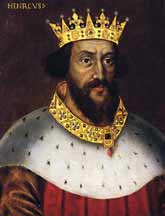Vader:
Willem I de Veroveraar van Normandië
Moeder:
Mathilde van Vlaanderen
- Geboren: in 1068 te Selby (Yorkshire)
- Koning van Engeland
- Overleden: op 1 december 1135 (ongeveer 67 jaar oud) te Saint-Denis-Le-Fermont (bij Gisors) Hij was na een jachtpartij in Normandië hongerig aangevallen op een bord lampreien.Een soort vissen waar hij dol op was, maar die hem altijd slecht bekwamen. Herhaaldelijk was hij gewaarschuwd om er af te blijven, maar hij wilde niet luisteren. Hij smulde er van en stierf twee dagen later
- Begraven: op 4 januari 1136 te Reading
Bijgenaamd Baeuclerk. Ridder, Westminster 13 Mei 1086, graaf van Coutnaces en Bayeux 1096, meester van de schatkist in Winchester 2 Augustus 1100. Volgde drie dagen later zijn broer Willem II op als koning van Engeland van 1100 -1135 en werd in de Westminster Abbey gekroond op 5 Augustus 1100. Hertog van Normandië 28 September 1106. Stichtte een abdij in Reading, waar hij later begraven zou worden. King Henry I "Beauclerc" of England, was born in Sep 1068 in Selby, Yorkshire, died on 11 Dec 1135 in Gisors, St. denis, Seine-St. denis, France and was buried on 4 Jan 1136 in Reading Abbey, Reading, Berks, England. Notes: Henry I was the fourth and most capable son of William the Conqueror and Matilda, born 1068, and nicknamed "Beauclerc" (fine scholar) for his above average education. He married Eadgyth (who later took the name Matilda), daughter of Malcolm III of Scotland, who bore him two sons and a daughter. One son died very early, and the other, William, died in the wreck of the White Ship in November 1120, leaving the daughter, Matilda, as the sole heir. Eadgyth died in 1118, and Henry married Adelaide of Louvain, but the union produced no offspring. Henry also had two fairly significant illegitimate children - Robert de Mellent, Earl of Gloucester, and Sibylla, wife of the Scottish King Alexander I. Henry's was the longest reign of the Norman line, lasting thirty-five years. The first years of Henry's reign were concerned with subduing Normandy. His father divided his kingdoms between Henry's older brothers, leaving England to William and Normandy to Robert. Henry inherited no land, but received £ 5000 in silver. He played both sides in his brothers' quarrel, leading both to distrust Henry, and sign a mutual accession treaty barring their brother from the crown. Henry's hope arose when Robert went on the First Crusade; should William die, Henry would be the obvious choice. Henry was in the woods hunting on the morning of William's death, August 2, 1100. He moved quickly and was crowned king on August 5, his coronation charter denouncing William's oppressive policies and promising good government. Robert returned to Normandy a few weeks later, but escaped final defeat until 1106, at the Battle of Tinchebrai. Robert was captured and lived the remaining twenty-eight years of his life as Henry's prisoner. Henry was drawn into controversy with the Church over the lay investiture issue - the practice of selling clergy appoints by the king to gain revenue, heavily opposed by Gregorian reformers in the Church. He ignored the situation until he was threatened with excommunication by Pope Paschal II in 1105, reaching a compromise with the papacy: he would officially denounce lay investiture, but prelates were to continue to do homage for their fiefs. In practice, it changed little - the king still had the deciding voice in appointing ecclesiastical offices - but it a marked a point when kingship was viewed as purely secular, and subservient to the Church. A solution to the lay investiture controversy and conquest of Normandy were accomplished in 1106, allowing Henry to expand his power. Henry mixed generosity with violence in motivating allegiance to the crown, appointing loyal and gifted men to administrative positions. Roger of Salisbury, the most famous of Henry's servants, was instrumental in organizing a department for collection of royal revenues, the Exchequer. The Exchequer quickly gained notoriety for sending out court officials to judge local financial disputes, weakening the feudal courts controlled by local lords, and won the title "Lion of Justice". The final years of his reign were concentrated on war with France and succession concerns upon the death of his son William in 1120. The marriage to Adelaide was fruitless, leaving Matilda his only surviving legitimate heir. She was recalled to Henry's court in 1125 after the death of her husband, Emperor Henry V of Germany; Henry forced the barons to swear they would accept Matilda as Queen upon Henry's death. She was then forced to marry the sixteen -year-old Geoffrey of Anjou (founder of the Plantagent dynasty) in 1128 to continue the Angevin alliance. The marriage was unpopular with the Norman barons, but Matilda and Geoffrey produced a male heir, prompting Henry to force another oath from the barons in support of Matilda. In summer 1135, Henry refused to give custody of certain key Norman castles to Geoffrey, as a show of good will, and the pair entered into war. Henry's life ended in this sorry state of affairs - war with his son-in-law - in December 1135. Henry married 1 Edith (Eda) FitzForne, daughter of Forne FitzSigulf and Unknown. (Edith (Eda) FitzForne was born About 1084 in of, Greystoke, Cumberland, England., died About 1152, buried in Oseney Abbey,, Oxford, England..)
Henry had a mistress 1.
Henry had a mistress 2.
Henry had a mistress 3.
Henry had a mistress 4.
Henry had a mistress. 5.
Henry had a mistress 6 in 1084 -1095.
Henry also had a mistress 7 Edith About 1086. Edith died after 1130
Henry had a mistress 8 Ansfride (of Abingdon Abbey) About 1090.
Henry had a mistress 9 About 1090.
Henry had a mistress 10 after 1090
Laatst gewijzigd:
12 februari 2025
link:
https://ngv-stambomen.nl/Hagenbeek/2783
Gekopieerd!
E-mail een vraag aan Cees Hagenbeek over deze persoon.



